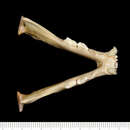en
names in breadcrumbs


The kodkod is the size of a tiny house cat but has a smaller head and shorter, thicker tail relative to its large feet and claws, which help it climb trees (4,12). It is one of the smallest cats in the Americas, joined only by the oncilla (2,10). It weighs 1.5-3 kg (10). The body is 40-52 cm and the tail19-25 cm long(11). The sexes look alike. The body is covered with buff to greyish- or reddish-brown fur, heavily patterned with small black spots that may form broken streaks on the head and neck and pale undersides and sides (2,4,10,13). Its small head has low-set ears, the backs of which are black, often with a white eyespot in the centre (10). The short, bushy tail is marked with narrow, black bands (2) and the large feet aid its proficient climbing abilities (4). Melanistic, or darker colored, kodkods are not uncommon and their stripes and spots are often detectable in bright light (4). The kodkod looks similar to Geoffroy's cat, but has less distinct stripes on its head and shoulder regions and has a have thicker tail (4). The kodkod has the the smallest distribution of any New World cat. It occurs in central and southern Chile, including the islands of Chiloé and the Guaitecas Archipelago and marginally in a small region on the eastern slopes of the Andes in western Argentina (2,7). It is the only small felid to occur over most of its range, although on the eastern limit, in Argentina, it is sympatric with the Geoffroy’s cat (8). Its area of occupancy is fragmented due to loss of its native temperate forest habitat; Acosta-Jamett et al. (9) estimated that there were 24 separate subpopulations in central Chile. The kodkod tends to live in evergreen temperate rainforests, deciduous temperate moist forests, sclerophyllous scrub and coniferous forestsand on mountains from 50-2,500 m (2,4,13). It is somewhat tolerant of disturbance, as it can be found in primary and secondary forest and scrub and the outskirts of settled and cultivated areas (3,13). It is often seen in Chilean Valdivian and Araucaria forests, which include altitudes of 1,900-2,500 m, complex multi-layered structures with bamboo, lianas, and epiphytes (2,5). It also lives in Argentinian moist montane forests with bamboo, lianas, and epiphytes (3,13). The presence of primary forest corridors is likely an important component of its long term persistence in human dominated landscape (7,9,14).
In southern Chile, where the kodkod lives in beech Nothofagus forest, Freer (15) found that it prefers areas of dense shrubby understory (thicket-forest) over primary forest.
Males occupy large areas, which overlap the smaller ranges of one or more females (2). On Chiloe Island, in a largely agricultural landscape, Sanderson et al. (7) found home ranges of 6.5 km² for males and 1.2 km² for females. Freer (15) reported smaller home ranges (MCP95) of 1.3 km² for males and 1 km² for females from two national parks in southern Chile. The kodkod is terrestrial and arboreal. It hunts prey on the ground, but it is an excellent climber (2) and climbs trees when escaping a pursuing predator or to take temporary shelter in the branches (4). It is primarily nocturnal, but can also be active during the day (2,4) and rests in dense vegetation, often hidden amongst almost impenetrable bamboo (2). Like most small cats, it has excellent senses of vision, hearing and smell. It probably uses chemical cues in communication as well as vocalizations, body postures and tactile cues.
This secretive predator stalks through thick vegetation and feeds on various birds, including domestic geese and chickens, and also consumes small rodents, insects and small lizards and other small reptiles (2,4,10). Kodkods in southern Chile feed mainly on rodents and other small mammals, but often take birds. They scavenge opportunistically on carrion (15). Predators of kodkods include humans and domestic dogs (6). Kodkods are cryptically coloured and secretive and avoid most predators. The larger home ranges of males may indicate that they range widely in search of multiple mates. Females give birth to litters of 1-4 young, after a gestation of 72-78 days (4). Like other small cats, the females probably provide the only parental care. They invest significantly in gestation and lactation and may provide extended care for the young, protecting them and teaching them to hunt before they become independent. The kodkod reaches sexual maturity at about 24 months (10) and may live up to 11 years in the wild (4), but a wild caught specimen was about 14.3 years when it died in captivity (1).
The kodkod is rare. Farmers may kill kodkods that take domestic poultry (10), but kodkods help control rodent populations (13).
There are two subspecies: L.g. tigrillo and L.g. guigna. The former lives in southern Patagonia and has a paler coat colour without spot markings on the feet (13).L.g. guigna lives in central Chile and has a smaller body, brighter colours and spot markings on the feet (13).<